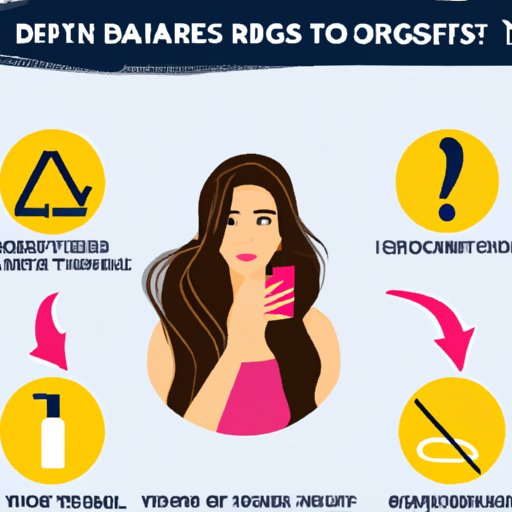Introduction
Have you ever looked in the mirror and noticed that your hair looks dull and lifeless? Chances are, it may be damaged. But what does damaged hair look like? In this article, we’ll explore what causes hair damage and provide a visual guide to help you identify signs of damage. We’ll also offer DIY tips for repairing and restoring life to dry, brittle hair, as well as a list of the best products to revive damaged locks.

A Visual Guide to Identifying Damaged Hair
One of the most obvious signs of damaged hair is split ends. This occurs when the protective cuticle of the hair strand has been stripped away, leaving the inner cortex exposed. Split ends can appear as white dots at the end of the hair shaft, or as frayed, jagged edges.
Another common sign of damage is an increase in tangles and knots. This is caused by the cuticle breaking down, allowing the hair to become tangled more easily. If you’re experiencing a lot of breakage, there’s a good chance your hair has been damaged.
In addition, damaged hair often looks and feels dry and brittle. When the cuticle is stripped away, it can no longer retain moisture, which leads to dryness and brittleness. You might also notice that your hair lacks shine and luster, another sign of damage.
To properly assess the condition of your hair, it’s important to take a closer look. Use a magnifying mirror and a bright light to examine each strand from root to tip. Pay close attention to any areas that look dull or brittle, as these are likely signs of damage.

DIY Tips for Repairing Damaged Hair
The first step in repairing damaged hair is to avoid heat styling. Heat can further damage the cuticle and strip away natural oils, so opt for air drying or using a blow-dryer on the lowest setting.
Next, use a deep conditioner regularly. Deep conditioners contain ingredients that help fill in cracks in the cuticle and restore moisture. Leave the conditioner on for at least 15 minutes before rinsing.
Limit washing and chemical treatments such as perms, relaxers, and color. These treatments can strip away the protective cuticle layer and make hair more susceptible to damage. If you do use them, be sure to use products specifically designed for color treated or chemically processed hair.
Finally, try some natural remedies to help repair damaged hair. Coconut oil is a great option for restoring moisture and adding shine. You can also use apple cider vinegar to help remove product buildup and balance the pH level of your scalp.
How to Restore Life to Dry, Brittle Hair
Once you’ve taken steps to stop further damage, it’s time to focus on reviving your hair. Start by moisturizing your hair with a nourishing shampoo and conditioner. Look for products that are free of harsh chemicals, sulfates, and parabens.
Next, use an oil or treatment mask to add even more moisture. Coconut oil, argan oil, and olive oil are all great options. Leave the treatment on for at least 15 minutes before rinsing.
Finally, trim split ends. While this won’t repair the damage, it will prevent it from getting worse. Have your ends trimmed every 6-8 weeks to keep them healthy and strong.
Common Causes of Hair Damage and How to Avoid Them
There are several things that can cause hair damage. Heat styling is one of the most common culprits. Overusing heated tools such as curling irons, flat irons, and blow-dryers can strip away the protective cuticle layer and leave hair dry and brittle.
Chemical treatments such as coloring, bleaching, and straightening can also cause damage. These treatments can strip away the natural oils in your hair, leaving it vulnerable to breakage and split ends.
Finally, environmental factors such as sun exposure, wind, and chlorine can cause damage. To protect your hair from these elements, wear a hat or scarf when you’re outdoors, and use a leave-in conditioner after swimming.

The Best Products for Reviving Damaged Hair
When it comes to reviving damaged hair, the right products can make a big difference. Look for shampoos and conditioners that are specifically designed for dry, brittle hair. Opt for ones that are free of sulfates and other harsh chemicals, and look for nourishing ingredients like coconut oil and shea butter.
Leave-in treatments can also help to restore moisture and shine. Look for ones that are lightweight and non-greasy, as these are less likely to weigh your hair down. You can also use a hair mask once or twice a week to give your hair an extra boost of nourishment.
Conclusion
Damaged hair can be identified by its lack of shine, increased tangles, split ends, and dry, brittle texture. Taking steps to repair and revive your hair is essential for maintaining healthy locks. Avoid heat styling, limit washing and chemical treatments, and use natural remedies to help restore moisture. Be sure to use the right products to help revive your hair, and trim split ends regularly to keep them healthy.
By following these tips, you can help restore life to your dry, brittle locks and have beautiful, healthy hair.


